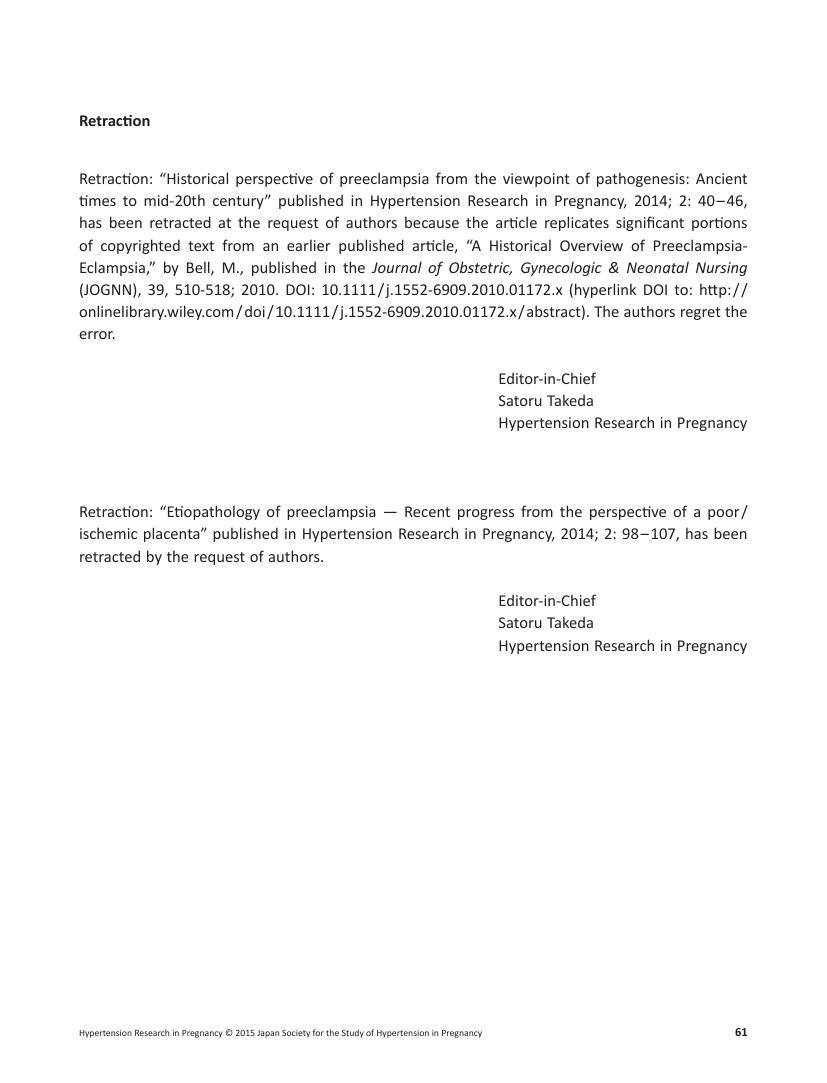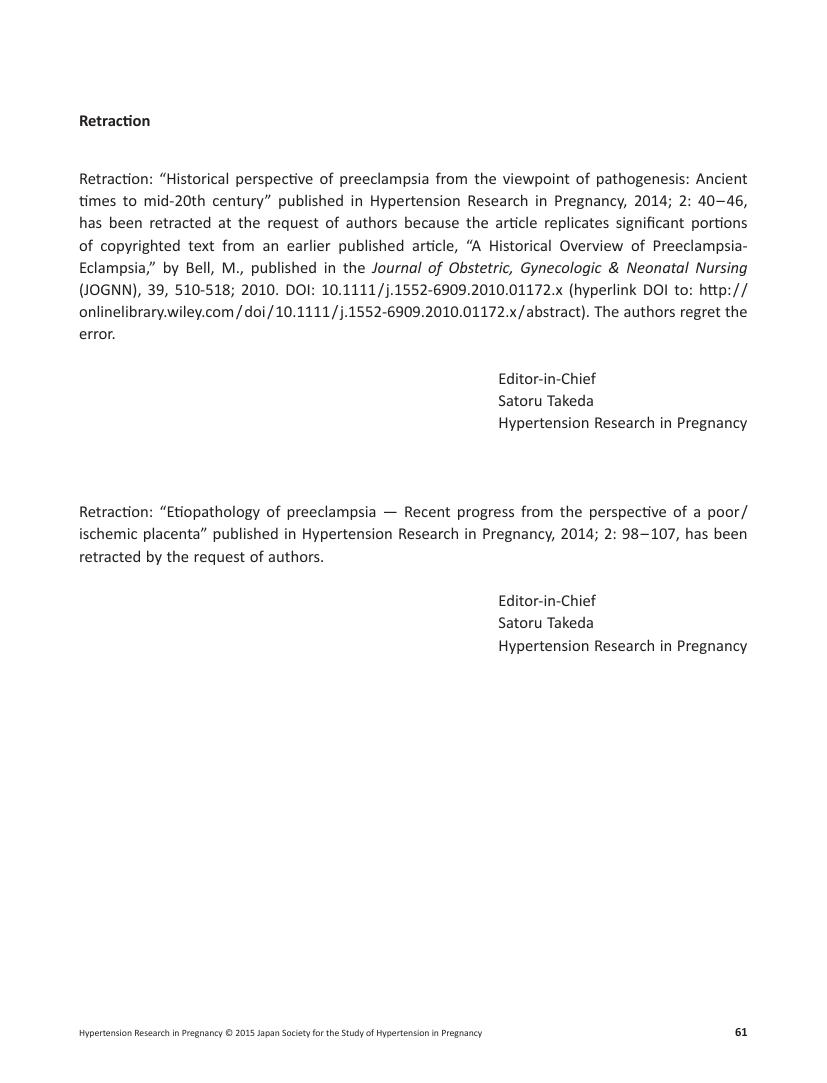- 著者
- Tomomi Yamazaki Ana Sofia Cerdeira Swati Agrawal Iemasa Koh Jun Sugimoto ManuVatish Yoshiki Kudo
- 出版者
- Japan Society for the Study of Hypertension in Pregnancy
- 雑誌
- Hypertension Research in Pregnancy (ISSN:21875987)
- 巻号頁・発行日
- pp.HRP2020-012, (Released:2020-11-01)
- 参考文献数
- 44
- 被引用文献数
- 1
Preeclampsia is a major complication of pregnancy and is associated with significant fetal and maternal morbidity and mortality. Timely prediction of preeclampsia facilitates referral of potential patients to an adequate tertiary center, which helps reduce adverse outcomes associated with the disease. Moreover, by accurately ruling out preeclampsia, patients can be discharged safely and relieved of anxiety. Numerous candidate biomarkers have been proposed for the diagnosis and prediction of preeclampsia. Among these, maternal circulating factors such as soluble FMS-like tyrosine kinase-1 (sFlt-1), an anti-angiogenic factor, and placental growth factor (PlGF), an angiogenic factor, are considered the most promising. Measuring these factors as a ratio allows assessment of the angiogenic imbalance that characterizes incipient or overt preeclampsia. The sFlt-1/PlGF ratio increases before the onset of preeclampsia and thus may help predict the disease. The test is used as a predictive tool in several countries but not yet routinely performed in Japanese hospitals.We performed a systematic review of studies that assessed the performance of the sFlt-1/PlGF ratio in predicting preeclampsia in Japanese patients. Three studies were included in the systematic review. All studies reported high negative predictive values of the sFlt-1/PlGF ratio (i.e., for ruling out PE), in agreement with the current evidence of the test performance worldwide. The sFlt-1/PlGF ratio could be of significant relevance in the Japanese population.
- 著者
- Atsuo Hidaka Osamu Nakamoto
- 出版者
- 日本妊娠高血圧学会
- 雑誌
- Hypertension Research in Pregnancy (ISSN:21875987)
- 巻号頁・発行日
- vol.3, no.1, pp.61_2-61_2, 2015 (Released:2015-08-04)
- 著者
- Atsuo Hidaka Osamu Nakamoto
- 出版者
- 日本妊娠高血圧学会
- 雑誌
- Hypertension Research in Pregnancy (ISSN:21875987)
- 巻号頁・発行日
- vol.3, no.1, pp.61_1-61_1, 2015 (Released:2015-08-04)
- 著者
- Hiroto Hirashima Kyoko Kaminaga Yohei Koyashiki Kenichi Tabata Rie Usui Akihide Ohkuchi
- 出版者
- Japan Society for the Study of Hypertension in Pregnancy
- 雑誌
- Hypertension Research in Pregnancy (ISSN:21875987)
- 巻号頁・発行日
- vol.9, no.1, pp.11-16, 2021-02-26 (Released:2021-02-26)
- 参考文献数
- 7
- 被引用文献数
- 3
Uterine necrosis after uterine artery embolization (UAE) for postpartum hemorrhage (PPH) is relatively rare. A 29-year-old primiparous woman had a diamniotic dichorionic twin pregnancy following frozen blastocyst transfer. She developed preeclampsia at 34+3 weeks, and cesarean section was performed due to lung edema at 35+2 weeks. UAE was performed using a gelatin sponge 3 hours after the operation due to PPH; however, the hemorrhage continued, and we performed a second UAE using n-butyl-2-cyanoacrylate. Uterine subinvolution continued after the second UAE, and her fever recurred 11 days after the operation. Magnetic resonance imaging suggested uterine necrosis 14 days after the operation, resulting in hysterectomy. The present study reviewed 17 cases of uterine necrosis following UAE in women with PPH, fever, abdominal/pelvic pain and found that delayed appearance of various symptoms was common. A long-lasting subinvolution may be a novel specific feature of uterine necrosis in women with UAE due to PPH.
- 著者
- Morio Sawada Miyoko Waratani Yoichiro Fujiwara Tomoharu Okubo Eiji Kondoh
- 出版者
- Japan Society for the Study of Hypertension in Pregnancy
- 雑誌
- Hypertension Research in Pregnancy (ISSN:21875987)
- 巻号頁・発行日
- pp.HRP2020-015, (Released:2020-10-03)
- 参考文献数
- 2
- 著者
- Liangcheng Wang Kohei Hamamoto Azusa Kimura Aya Ishiguro Isao Horiuchi Kenjiro Takagi
- 出版者
- Japan Society for the Study of Hypertension in Pregnancy
- 雑誌
- Hypertension Research in Pregnancy (ISSN:21875987)
- 巻号頁・発行日
- pp.HRP2020-001, (Released:2020-06-10)
- 参考文献数
- 8
Intrauterine balloon tamponade (IBT) is widely used for treating obstetric hemorrhage. However, only a few reports on IBT failure exist. We report a case of IBT failure caused by an over-expanded lower uterine segment (LUS). A 30-year-old woman with twin pregnancy presented with bleeding after cesarean section. During surgery, uterine atony was observed; however, intravenous administration of oxytocin and ergometrine resolved the condition. Continuous hemorrhage was observed postoperatively, despite the administration of uterotonics and uterine massage. Although IBT was performed, the bleeding persisted, as recognized from the drainage fluid. Enhanced computed tomography revealed that the bleeding spot could not be compressed by the inflated balloon due to the over-expanded LUS. The balloon was removed; uterine artery embolization was required to achieve hemostasis. Our experience indicated that over-expanded LUS could cause IBT failure. If bleeding continues post-IBT replacement and an over-expanded LUS is observed, alternative treatments should be promptly provided.
- 著者
- Takashi Yorifuji Jun Takeda Shintaro Makino Toshitaka Tanaka Atsuo Itakura Satoru Takeda
- 出版者
- Japan Society for the Study of Hypertension in Pregnancy
- 雑誌
- Hypertension Research in Pregnancy (ISSN:21875987)
- 巻号頁・発行日
- pp.HRP2018-001, (Released:2018-07-31)
- 参考文献数
- 24
- 被引用文献数
- 6
Aim: Several devices are used for balloon tamponade. In Japan, metreurynters are widely used for cervical ripening; however, there is little evidence for their use in hemostatic uterine balloon tamponade. This study aimed to assess the non-inferiority of metreurynters as the balloon device for obstetric hemorrhage.Methods: Medical charts of all patients with obstetric hemorrhage of more than 1,000 ml who underwent balloon tamponade with metreurynters were retrospectively reviewed for five years at a tertiary referral university hospital.Results: A total of 89 uterine balloon tamponade cases were identified from medical records. Of these, 66 cases involved term postpartum hemorrhage (PPH) within 24 h after delivery (PPH group) and 23 involved other types of cases (other group), including cesarean scar pregnancy, cervical pregnancy, retained placenta, and others. In the PPH group, the average hemostasis rate was 93.9%, whereas the rate was 91.3% in the other group. Seven cases failed to achieve hemostasis with balloon tamponade only and required additional treatment. There were no adverse events related to balloon tamponade using metreurynters.Conclusions: Metreurynters used for balloon tamponade were non-inferior to Bakri balloons in hemostasis and complication rates, suggesting they are effective and appropriate for the management of obstetrical hemorrhage.
1 0 0 0 OA Critical appraisal of the role of applying uterine fundal pressure in labour: First, do no harm
- 著者
- Konstantinos Papadakis
- 出版者
- Japan Society for the Study of Hypertension in Pregnancy
- 雑誌
- Hypertension Research in Pregnancy (ISSN:21875987)
- 巻号頁・発行日
- vol.7, no.1, pp.22-26, 2019-03-30 (Released:2019-07-09)
- 参考文献数
- 21
Aim: Fundal pressure during labour is a frequently used manoeuvre for expediting delivery in cases of fetal distress, dystocia and maternal exhaustion. It is often underreported and therefore challenging to accurately estimate its prevalence. It remains a highly controversial topic, having been abandoned in many countries due to its potentially harmful consequences. Still, some health care professionals consider it safe and effective in life-threatening obstetric emergencies. Our objective was to evaluate the evidence behind the merits and drawbacks of its implementation into clinical practice.Methods: This is a critical review based on utilising high-quality references on whether it is justifiable to insist on using fundal pressure in contemporary obstetrics.Results: Fundal pressure is understudied with significant variations worldwide. Reports documenting of any substantial benefit are sparse in the literature. Nevertheless, there is a clear association with various adverse outcomes. An increasing number of experts suggest that fundal pressure should be relinquished.Conclusions: Unless future randomised controlled trials change our views on traditional methods for shortening labour when needed, practitioners should be extra vigilant in avoiding dubious techniques, as deviation from national guidelines could jeopardise aspirations for optimal intrapartum care. In the time being, fundal pressure should be limited for research purposes only within well-designed studies.
- 著者
- Kazushi Watanabe Keiichi Matsubara Osamu Nakamoto Junko Ushijima Akihide Ohkuchi Keiko Koide Shintaro Makino Kazuya Mimura Mamoru Morikawa Katsuhiko Naruse Kanji Tanaka Tomoyoshi Nohira Hirohito Metoki Ikuno Kawabata Satoru Takeda Hiroyuki Seki Kenjiro Takagi Mineo Yamasaki Atsuhiro Ichihara Tadashi Kimura Shigeru Saito
- 出版者
- Japan Society for the Study of Hypertension in Pregnancy
- 雑誌
- Hypertension Research in Pregnancy (ISSN:21875987)
- 巻号頁・発行日
- vol.6, no.2, pp.33-37, 2018-11-30 (Released:2019-03-28)
- 参考文献数
- 5
- 被引用文献数
- 61
- 著者
- Atsuo Hidaka Osamu Nakamoto
- 出版者
- Japan Society for the Study of Hypertension in Pregnancy
- 雑誌
- Hypertension Research in Pregnancy (ISSN:21875987)
- 巻号頁・発行日
- vol.2, no.2, pp.98-107, 2014 (Released:2015-02-06)
- 参考文献数
- 89
- 被引用文献数
- 1
この記事は撤回されました。
- 著者
- Satoru Takeda Jun Takeda Taro Koshiishi Shintaro Makino Katsuyuki Kinoshita
- 出版者
- 日本妊娠高血圧学会
- 雑誌
- Hypertension Research in Pregnancy (ISSN:21875987)
- 巻号頁・発行日
- vol.2, no.2, pp.65-71, 2014 (Released:2015-02-06)
- 参考文献数
- 17
- 被引用文献数
- 9
The precise reporting of fetal station is important in the decision-making regarding whether instrumental vaginal delivery or cesarean section should be performed. However, accurate evaluation of fetal station is difficult because it is defined on the basis of a hypothetical vertical midline to the ischial spines. Moreover, during delivery, the fetal head descends anteriorly into the pelvis along the pelvic axis and not in the vertical direction. DeLee’s concept of fetal station, first reported in 1924, has been revised by taking into account the fetal head descent along the pelvic axis, and this concept has been in clinical use at the University of Tokyo Hospital since the 1970s.In this review, we assess the problems associated with conventional fetal station and explain the new concept of fetal station based on the trapezoidal plane and assessment of head descent upon instrumental delivery.


